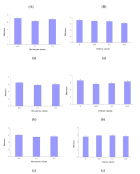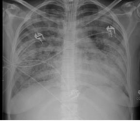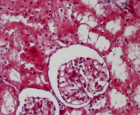Table of Contents
Production and characterization of staphylokinase enzyme from Staphylococcus aureus ASIA4
Published on: 17th September, 2020
OCLC Number/Unique Identifier: 8873194541
Six clinical Staphylococcus aureus strains isolated from different clinical samples. Isolates ASIA1 and ASIA2 isolated from urine samples of urinary tract infected patients; ASIA3 isolated from swab samples of burn abscess patients at Assiut University hospital as well as ASIA4, ASIA5 and ASIA6 obtained from blood samples of different cancer patients at South Egypt Cancer Institute. All isolates showed varied abilities to produce halo zones of hydrolysis with different diameters on blood agar, heated plasma agar, casein agar and skim milk agar plates along with different clot lyses percent. Staphylococcus aureus ASIA3, ASIA4 and ASIA6 produced 4.83, 5.98 and 2.08 U/mL of staphylokinase on tryptone soy broth reduced to 1.95, 2.08 and 1.70 U/mL on casein hydrolysate yeast extract broth, respectively. On the other hand, Staphylococcus aureus ASIA1, ASIA2 and ASIA5 gave 2.20, 2.93 and 3.65 U/mL on CYEB compared to 2.10, 1.88 and 3.41 U/mL on TSB as production medium. The staphylokinase yielded from the hyperactive producer Staphylococcus aureus ASIA4 was increased for 7.64-fold (from 2.08 U/mL to 15.88 U/mL) on the optimized fermentation medium composed of 5.0 g sucrose as carbon source, 10.0 g soy bean as nitrogen source, 5.0 g NaCl, K2HPO4 5.0 g and pH 7.0 that inoculated with isolate ASIA4 and incubated for 24 h at 35 °C. Moreover, Staphylokinase activity reached its peak at the optimal enzymatic reaction conditions which were reaction time 25 min, casein as substrate, reaction pH 8.0, reaction temperature 40 °C. In addition it retained 100% of its activity at temperature ranged between 15 and 45 °C and pH ranged from pH 6.0 to 9.0. EDTA inhibited the enzyme activity by 3.0% to 32.2% with increasing its values from 30.0 to 90.0 mM. MgCl2 at a concentration of 30 mM increased the enzyme activity by 4% and then slightly decreased at higher concentrations but NaCl was potent staphylokinase activator at concentrations lower than 90 mM.
Anticancer activity of novel surface functionalized metal doped hydroxyapatite
Published on: 3rd June, 2020
OCLC Number/Unique Identifier: 8616336600
In this manuscript it has been described a novel synthesis of mercury doped hydroxyapatite (Hap) and its application on human liver carcinoma cell line (Hep G2) and human lung fibroblast carcinoma cell line (MRC 5). Nano-sized hydroxyapatite doped with Hg2+ was synthesized by a solution based chemical method along with mercury ion. The surface of nanoparticle of mercury doped hydroxyapatite (MHAp) was functionalized by using phosphonomethyl iminodiacetic acid (PMIDA) for making it stable as dispersed phase with negative zeta potential. Surface functionalization was confirmed by FTIR measurements. Crystalline nature, morphology and surface topology were studied by powder XRD, FESEM and AFM measurements. Particle size of the well dispersed sample was obtained by HRTEM image. The studies on cell viability of Hep G2 and MRC 5 cell in presence of mercury doped HAp nanoparticle (MHAp) were determined through WST assay. It was observed that nanocomposite exhibited a site specific action towards MRC 5 cell lines along with reduction of toxicity toward normal cells.
Medicinal plant extract associated with bacterial cellulose membrane: Antibacterial activity and physicochemical properties
Published on: 4th February, 2020
OCLC Number/Unique Identifier: 8531081943
Burns injuries induce a state of immunodepression that predisposes to a bacterial infectious complication that leads to several comorbid diseases and high mortality rate. Previous studies about anti-inflammatory, antimicrobial and antioxidant properties of Aloe vera (L.) Burm., Calendula officinalis L.and Matricaria recutita L. are acknowledge by antimicrobial effects.
Previous studies about anti-inflammatory, antimicrobial and antioxidant properties of Aloe vera (L.) Burm., Calendula officinalis L. and Matricaria recutita L. are knowledge by antimicrobial effects. Bacterial cellulose membrane (nature BCM) is a potential carrier as a drug delivery system in the wound and burn treatment. The present study aimed to evaluate the antibacterial activity of extracts of A. vera, C. officinalis, and M. recutita incorporated in BCM against bacterial strains commonly present in wound and burns. The agar-dilution susceptibility testing was used to determine the minimum inhibitory concentration (MIC) for S. aureus, E. coli, and P. aeruginosa. The standardized extracts of A. vera, M. recutita, and C. officinalis were, respectively, used at 3.25% of total polysaccharides, 1% of apigenin 7-O-glucoside and 0.084% of total flavonoids expressed in quercetin. The BCM incorporated with A. vera extract was efficient to prevent the growth of P. aeruginosa and S. aureus. BCM loaded with C. officinalis inhibited the growth of S. aureus. The BCM loaded with A. vera and C. officinalis extract showed better antibacterial activities against P. aeruginosa and S. aureus and, consequently, properties to prevent infectious disease in the wound or burn caused by these bacteria.
Biological markers of oxidative stress in exhaled air
Published on: 31st January, 2020
OCLC Number/Unique Identifier: 8535889757
Nearly all energy production in living organisms is by oxidation reactions (fires are large oxidative embers)
Oxidation reactions produce, through complex intermediate steps, small energy packages that are more easily stored than a sudden combustion oxidation. The slow and controlled production of energy in a nuclear power plant allows its use, a massive explosion produces the result that we know ... It’s the same thing in our bodies. These reactions are never 100% efficient, not all the energy produced is used as bio fuel. Indeed, during the intermediate stages, they induce a deterioration of cells and tissues by consuming about 10% of this energy. They cause significant “wear and tear” when there is no longer any compensation for these parasitic oxidations. The latter can be excessively used in pathological situations inducing inflammatory reactions, or simply during metabolic overproduction, or even simple intense and prolonged efforts.
Antiuropathogenic and antioxidant activities of Hypoxis hemerocallidea Lam. extracts, and compounds from its taxonomically related species
Published on: 22nd January, 0020
OCLC Number/Unique Identifier: 8529692786
Hypoxis hemerocallidea Lam is one of the 43 Hypoxis species in South Africa, marketed extensively as over the counter herbal product for the management of several diseases. The plant commercial products link efficacy to hypoxoside 4, its aglycone (rooperol), or β-sitosterol. This study investigated antibacterial and anti-oxidant activities of four other molecules and two extracts from the Hypoxis plant. Visual antioxidant limit of detection and free radical scavenging activities of test samples were determined using 20 mM hydrogen peroxide, 0.4 mM DPPH or ferric reducing antioxidant power assay. Quantitative free radical was determine by spectrophotometric method while antibacterial activity was evaluated using MICs against uropathogens: S. aureus (ATCC25923), S. marcescens (ATCC 14041), P. aeruginosa (ATCC 9721), P. mirabilis (ATCC 33583) and E. coli (ATCC 10536).
Anti-oxidant activities visual limit of detection of 0.06 mg/mL and percentage free radical scavenging activity (IC50 = 0.048 - 0.032 mg/ml) for pure compounds 1 - 4 and (IC50 = 0.037 - 0.039 mg/ml) for extracts were obtained. The reducing power IC50 ranged between 0.15 - 0.23 mg/ml for extracts and 0.11-0.35 mg/ml for standards. Antibacterial potentials show a noteworthy to moderate MIC values of 0.20 - 1.56 mg/ml against S. aureus (ATCC 25923), S. marcescens (ATCC 14041), P. aeruginosa (ATCC 9721), P. mirabilis (ATCC 33583) and E. coli (ATCC 10536). Galpinoside 5, hemerocalloside 3 and curculigoside C 2 are the other active compounds in Hypoxis plant.

HSPI: We're glad you're here. Please click "create a new Query" if you are a new visitor to our website and need further information from us.
If you are already a member of our network and need to keep track of any developments regarding a question you have already submitted, click "take me to my Query."



















































































































































